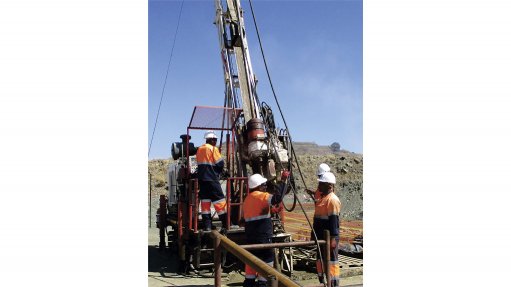
DOING THE HOLE JOB The geotechnical investigations required the drilling of two holes in the North pit and five in the South pit at depths of between 300 m and 500 m
Drilling company Geomech Africa, part of geotechnical services holding company GeoGroup, has completed its geotechnical investigation at phosphate product producer and distributor Foskor’s phosphate mining operation in Phalaborwa, Limpopo.
The Foskor phosphate mine comprises the North and South pits and is located at the northern edge of the Phalaborwa complex, which hosts several mines operated by different companies.
The objective of the project is to identify the continuity of the rock, and the data obtained will be used to help optimise the design and mine planning for the North and South pits.
The fieldwork started in August last year and was concluded by November, says GeoGroup works director Grant Rijsmus.
Geomech Africa was awarded the drilling contract with the main purpose of acquiring sufficient geotechnical data for the optimisation of the North and South pits.
The project entailed drilling two holes in the North pit and five in the South pit at depths of between 300 m and 500 m. Geomech Africa used LF90 Boart Longyear and CS1500 Atlas Copco rigs, whose long-reach booms are specially designed for exploration drilling.
A survey tool was connected to the overshot and dropped to the bottom of the hole daily to read the direction of the hole so as to ensure the borehole remained within the -70º trajectory. Further, structural data comprising structural identifications and their respective orientations were measured using an acoustic televiewer, a down-the-hole geophysical method.
Acoustic televiewers enable geotechnical investigations to generate an image of the borehole wall by transmitting ultrasonic pulses from a fixed transducer with a rotating mirror, and then recording the amplitude and travel time of the signals reflected at the interface between the borehole fluid and the borehole wall rock formation.
There were instances where the upper sections of the rock mass were highly fractured, making the drilling and identification of strata more complex, Rijsmus explains.
“This meant that the holes had to be grouted in places to enable the drill to pass through larger cracks,” he says, adding that specific drilling muds were usedto help prevent the collapse of unstable strata into the borehole and the escape of essential cooling and lubricating drilling muds into open cracks.
Geomech drilling supervisor Kiewiet Mahlangu tested various muds in different scenarios and assessed their respective impacts on the rock formations as the drill advanced, until the correct balance was found.
Meanwhile, GeoGroup is carrying out two drilling contracts at diversified miner Vedanta’s Skorpion zinc mine, located 25 km north of Rosh Pinah, in the Kharas region of southern Namibia.
The contracts involve geotechnical investigations, similar to the work done at Foskor, but in shallower holes of only 100 m in depth, and creating a means of draining water from the slope formation, which is causing slope instability.